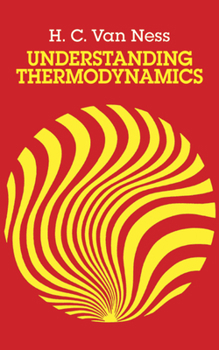Understanding Thermodynamics
Select Format
Select Condition 
Book Overview
Clearly written treament elucidates fundamental concepts and demonstrates their plausibility and usefulness. Language is informal, examples are vivid and lively, and the perspectivie is fresh. Based... This description may be from another edition of this product.
Format:Paperback
Language:English
ISBN:0486632776
ISBN13:9780486632773
Release Date:January 1983
Publisher:Dover Publications
Length:128 Pages
Weight:0.35 lbs.
Dimensions:0.3" x 5.4" x 8.0"
Customer Reviews
5 ratings
Excellent foundation
Published by Thriftbooks.com User , 18 years ago
Van Ness cures the common problem of vapid thermodynamics texts by clearly explaining the basics and then stopping. His little book is an easy read, and firmly roots the student in the reality of what thermodynamic laws and equations actually mean. Most importantly, van Ness repeatedly makes clear that thermodynamics is about imaginary processes that will never occur in real machines. This should be the first week's read of every course in thermo.
Highly recommended
Published by Thriftbooks.com User , 19 years ago
This book is an excellent conceptual introduction to thermodynamics. It helps you to get the "big picture" without getting into mathematical details. The first few chapters are suitable for high-school students that are interested in the fundamental concepts and laws of thermodynamics.
Excellent to understand the subject
Published by Thriftbooks.com User , 19 years ago
This book is excellent. I have taken several thermodynamic courses but still the concepts seem too abstract to have a complete grasp of the subject. This books makes it clear. The combination of Understanding Thermodynamics and Thermodynamics by Fermi are a powerful refresher.
Lucid Explanation of Thermodynamics - Highly Recommended
Published by Thriftbooks.com User , 20 years ago
Understanding Thermodynamics is an exceptional introduction to a subtle and complex topic. The First and Second Law of Thermodynamics are seemingly trivial, and yet an understanding of theoretical and applied thermodynamics often eludes even the best of students. This 100-page overview is much better than the chapter or two on thermodynamics in a first year physics text. It is a more lucid and interesting discussion than is even found in Feynman's Lectures in Physics, Volume 1.H. C. Van Ness, a professor of chemical engineering at Rensselaer Polytechnic Institute and expert in thermodynamics, approaches his subject in an uniquely interesting fashion, stressing that the First and Second Law are assumptions based on empirical data. They are fundamental statements that cannot be derived from other principles.In chapter 1 Van Ness borrows a humorous analogy from Feynman to explain the reasonableness of the abstract concept of internal energy and the relationship between internal energy, heat, and work.Chapter 2 introduces the concept of reversibility, and explains its fundamental importance to thermodynamics. In doing so he carefully exposes our underlying assumptions.In chapter 3, titled Heat Engines, Van Ness emphasizes that the reversible process represents the limiting behavior of actual systems, the best that we can hope for. Also, in most cases we are not even able to make calculations unless we simplify our problem by assuming that our system exhibits reversibility. Van Ness carefully explains the basic engineering calculations for both the Otto engine cycle and the Carnot theoretical heat engine.In chapter 4 Van Ness guides the reader carefully through detailed thermodynamic analysis of a large scale power plant. In doing so, he provides an intriguing look at the unintended and unavoidable environmental impact of large power plants.Van Ness introduces the Second Law of Thermodynamics by asking whether we can uncover any hidden relationships in a set of empirical data for reversible heat processes. After being led down several blind alleys, we unexpectedly discover a quantity that seems even more abstract than the concept of internal energy. We decide to call it entropy.The last two chapters - More on the Second Law, and Thermodynamics and Statistical Mechanics - were slightly more difficult. The section on statistical mechanics would normally be found in a physical chemistry textbook.The chapters are written in an informal manner, much like lectures. The mathematics assumes some calculus, but it is not any more difficult a first year physics text. It makes good independent reading, but Van Ness intended for Understanding Thermodynamics to be used along with a standard engineering or physics text. No problems sets are found at the end of the chapters.
Deals with the abstractness
Published by Thriftbooks.com User , 23 years ago
Thermo is hard for two reasons. The equations are messy, and the properties are so abstract. Van Ness deals directly and only with the second problem. His discussion of energy functions and energy transformations just as rules between observables is very helpful. Using that notion to get at what he means by a property and then making entropy understandable as a PROPERTY of a system is the core of much of the book. The derivation of some basic stuff in statistical mechanics is quite clear, and the logical relationship to classical thermo is very clear. An index would be nice.




